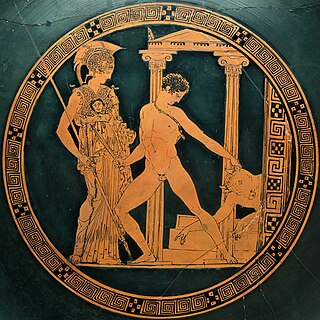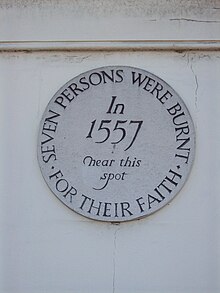
Heracles, born Alcaeus or Alcides, was a divine hero in Greek mythology, the son of Zeus and Alcmene, and the foster son of Amphitryon. He was a descendant and half-brother of Perseus. He was the greatest of the Greek heroes, the ancestor of royal clans who claimed to be Heracleidae (Ἡρακλεῖδαι), and a champion of the Olympian order against chthonic monsters. In Rome and the modern West, he is known as Hercules, with whom the later Roman emperors, in particular Commodus and Maximian, often identified themselves. Details of his cult were adapted to Rome as well.

Jason was an ancient Greek mythological hero and leader of the Argonauts, whose quest for the Golden Fleece is featured in Greek literature. He was the son of Aeson, the rightful king of Iolcos. He was married to the sorceress Medea, the granddaughter of the sungod Helios. He was also the great-grandson of the messenger god Hermes, through his mother's side.

In Greek mythology, Medea is the daughter of King Aeëtes of Colchis. In the myth of Jason and the Argonauts, she aids Jason in his search for the Golden Fleece. She later marries him, but eventually kills their children and his other bride according to some versions of her story. Medea is known in most stories as a sorceress and is often depicted as a priestess of the goddess Hecate. She first appears in Hesiod's Theogony around 700 BCE, but is best known from Euripides's tragedy Medea and Apollonius of Rhodes's epic Argonautica.

Deianira, Deïanira, or Deianeira, also known as Dejanira, is a Calydonian princess in Greek mythology whose name translates as "man-destroyer" or "destroyer of her husband". She was the wife of Heracles and, in late Classical accounts, his unwitting murderer, killing him with the poisoned Shirt of Nessus. She is the main character in Sophocles' play Women of Trachis.

The Argonauts were a band of heroes in Greek mythology, who in the years before the Trojan War accompanied Jason to Colchis in his quest to find the Golden Fleece. Their name comes from their ship, Argo, named after its builder, Argus. They were sometimes called Minyans, after a prehistoric tribe in the area.

In Greek mythology, Iole was the daughter of King Eurytus of Oechalia. According to the brief epitome in the Bibliotheca, Eurytus had a beautiful young daughter named Iole who was eligible for marriage. Iole was claimed by Heracles for a bride, but Eurytus refused her hand in marriage. Iole was indirectly the cause of Heracles' death because of his wife's jealousy of her.
In Greek mythology, Glauce, Latin Glauca, refers to different people:
Medea is a tragedy by the ancient Greek playwright Euripides based on a myth. It was first performed in 431 BC as part of a trilogy, the other plays of which have not survived. Its plot centers on the actions of Medea, a former princess of the kingdom of Colchis and the wife of Jason; she finds her position in the world threatened as Jason leaves her for a princess of Corinth and takes vengeance on him by murdering his new wife and her own two sons, before escaping to Athens to start a new life.

In Greek mythology, Nessus was a famous centaur who was killed by Heracles, and whose poisoned blood in turn killed Heracles. He was the son of Centauros. He fought in the battle with the Lapiths and became a ferryman on the river Euenos.

In Greek mythology, the Shirt of Nessus, Tunic of Nessus, Nessus-robe, or Nessus' shirt was the poisoned shirt (chiton) that killed Heracles. It was once a popular reference in literature. In folkloristics, it is considered an instance of the "poison dress" motif.

Women of Trachis or The Trachiniae c. 450–425 BC, is an Athenian tragedy by Sophocles.

Medea is a 1969 Italian film directed by Pier Paolo Pasolini, based on the ancient myth of Medea. The film stars opera singer Maria Callas in her only film role and is largely a faithful portrayal of the myth of Jason and the Argonauts and the events of Euripides' play The Medea.
A tunica molesta was a tunic impregnated with pitch and other flammable substances such as naphtha or resin. This was put upon the victim while the neck of the victim was fixed to a stake with an iron collar. It was then ignited, burning the victim alive. Tunicae molestae were used for execution and torture in the Roman Empire.

The Argonautica is a Greek epic poem written by Apollonius Rhodius in the 3rd century BC. The only entirely surviving Hellenistic epic, the Argonautica tells the myth of the voyage of Jason and the Argonauts to retrieve the Golden Fleece from remote Colchis. Their heroic adventures and Jason's relationship with the dangerous Colchian princess/sorceress Medea were already well known to Hellenistic audiences, which enabled Apollonius to go beyond a simple narrative, giving it a scholarly emphasis suitable to the times. It was the age of the great Library of Alexandria, and his epic incorporates his research in geography, ethnography, comparative religion, and Homeric literature. However, his main contribution to the epic tradition lies in his development of the love between hero and heroine – he seems to have been the first narrative poet to study "the pathology of love". His Argonautica had a profound impact on Latin poetry: it was translated by Varro Atacinus and imitated by Valerius Flaccus, it influenced Catullus and Ovid, and it provided Virgil with a model for his Roman epic, the Aeneid.

Médée is a tragédie mise en musique in five acts and a prologue by Marc-Antoine Charpentier to a French libretto by Thomas Corneille. It was premiered at the Théâtre du Palais-Royal in Paris on December 4, 1693. Médée is the only opera Charpentier wrote for the Académie Royale de Musique. The opera was well reviewed by contemporary critics and commentators, including Sébastien de Brossard and Évrard Titon du Tillet, as well as Louis XIV whose brother attended several performances, as did his son; however, the opera only ran until March 15, 1694, although it was later revived at Lille.
The tale known as "The Poison Dress" or "Embalmed Alive" features a dress that has in some way been poisoned. This is a recurring theme throughout legends and folktales of various cultures, including ancient Greece, Mughal India, and the United States. Although lacking evidence suggesting that some American urban legends are directly linked to the classical tales, they share several common motifs.

Medea is a 1988 Danish tragedy television film directed by Lars von Trier. It is based on Carl Theodor Dreyer's adaptation of Euripides' play Medea. The setting is changed from the Mediterranean to a danish, vaguely iron age setting.

Medea is a fabula crepidata of about 1027 lines of verse written by Seneca the Younger. It is generally considered to be the strongest of his earlier plays. It was written around 50 CE. The play is about the vengeance of Medea against her betraying husband Jason and King Creon. The leading role, Medea, delivers over half of the play's lines. Medea addresses many themes, one being that the title character represents "payment" for humans' transgression of natural laws. She was sent by the gods to punish Jason for his sins. Another theme is her powerful voice that cannot be silenced, not even by King Creon.

Hercule mourant is an opera by the French composer Antoine Dauvergne, first performed at the Académie Royale de Musique on 3 April 1761. It takes the form of a tragédie lyrique in five acts. The libretto, by Jean-François Marmontel, is based on the tragedies The Women of Trachis by Sophocles and Hercule mourant, ou La Déjanire (1634) by Jean Rotrou.

In Greek mythology, Creusa or Glauce, Latin Glauca, was a princess of Corinth as the daughter of King Creon.


















